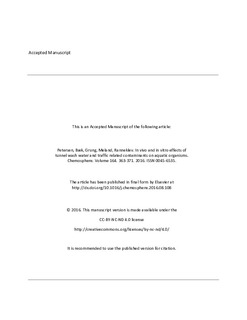| dc.contributor.author | Petersen, Karina | |
| dc.contributor.author | Bæk, Kine | |
| dc.contributor.author | Grung, Merete | |
| dc.contributor.author | Meland, Sondre | |
| dc.contributor.author | Ranneklev, Sissel Brit | |
| dc.date.accessioned | 2018-09-06T06:54:38Z | |
| dc.date.available | 2018-09-06T06:54:38Z | |
| dc.date.created | 2016-11-06T23:42:04Z | |
| dc.date.issued | 2016 | |
| dc.identifier.citation | Chemosphere. 2016, 164 363-371. | nb_NO |
| dc.identifier.issn | 0045-6535 | |
| dc.identifier.uri | http://hdl.handle.net/11250/2561084 | |
| dc.description.abstract | In order to maintain the construction and safety of road tunnels, they are routinely washed. The wash water appears to be highly polluted with a plethora of contaminants in elevated concentrations. In addition, new and emerging compounds are likely to occur. The discharge water has shown acute toxic and sub-lethal effects in several organisms. In this study, ecotoxicity tests with algae (Pseudokirchneriella subcapitata) and in vitro tests with primary rainbow trout (Oncorhynchus mykiss) hepatocytes were used to characterize the effect of TWWfrom three different tunnels. In addition, selected N- and Cl-PAHs were tested for cytotoxicity, EROD activity and CYP1A protein production. TWW samples and/or extracts from two tunnels reduced the algal growth and induced cytotoxicity, EROD activity and CYP1A protein production in vitro. Four of the eight tested Cl- and N-substituted PAHs induced EROD activity and CYP1A protein production at micro-molar concentrations. N-PAHs were detected in samples from the tunnel wash, highlighting substituted PAHs as potentially important traffic-related contaminants. | nb_NO |
| dc.language.iso | eng | nb_NO |
| dc.publisher | Elsevier | nb_NO |
| dc.rights | Attribution-NonCommercial-NoDerivatives 4.0 Internasjonal | * |
| dc.rights.uri | http://creativecommons.org/licenses/by-nc-nd/4.0/deed.no | * |
| dc.title | In vivo and in vitro effects of tunnel wash water and traffic related contaminants on aquatic organisms | nb_NO |
| dc.title.alternative | In vivo and in vitro effects of tunnel wash water and traffic related contaminants on aquatic organisms | nb_NO |
| dc.type | Journal article | nb_NO |
| dc.type | Peer reviewed | nb_NO |
| dc.description.version | acceptedVersion | nb_NO |
| dc.source.pagenumber | 363-371 | nb_NO |
| dc.source.volume | 164 | nb_NO |
| dc.source.journal | Chemosphere | nb_NO |
| dc.identifier.doi | 10.1016/j.chemosphere.2016.08.108 | |
| dc.identifier.cristin | 1397832 | |
| dc.relation.project | Statens Vegvesen: 603019 | nb_NO |
| cristin.unitcode | 7464,20,13,0 | |
| cristin.unitcode | 7464,30,21,0 | |
| cristin.unitcode | 7464,30,12,0 | |
| cristin.unitname | Økotoksikologi | |
| cristin.unitname | Miljøkjemi | |
| cristin.unitname | Akvatiske miljøgifter | |
| cristin.ispublished | true | |
| cristin.fulltext | postprint | |
| cristin.qualitycode | 1 | |

